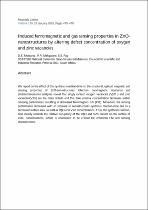 ResearchSpace
ResearchSpace
Induced ferromagnetic and gas sensing properties in ZnO-nanostructures by altering defect concentration of oxygen and zinc vacancies
JavaScript is disabled for your browser. Some features of this site may not work without it.
- ResearchSpace
- →
- Research Publications/Outputs
- →
- Journal Articles
- →
- View Item
| dc.contributor.author |
Motaung, DE

|
|
| dc.contributor.author |
Makgwane, Peter R

|
|
| dc.contributor.author |
Ray, SS

|
|
| dc.date.accessioned | 2016-05-16T10:14:22Z | |
| dc.date.available | 2016-05-16T10:14:22Z | |
| dc.date.issued | 2015-01 | |
| dc.identifier.citation | Motaung, D.E. Makgwane, P.R. and Ray, S.S. (2015) Induced ferromagnetic and gas sensing properties in ZnO-nanostructures by altering defect concentration of oxygen and zinc vacancies. Materials Letters, 139, 475-479 | en_US |
| dc.identifier.issn | 0167-577X | |
| dc.identifier.uri | http://www.sciencedirect.com/science/article/pii/S0167577X14018618 | |
| dc.identifier.uri | http://hdl.handle.net/10204/8534 | |
| dc.description | Copyright: 2015 Elsevier. Due to copyright restrictions, the attached PDF file only contains the abstract of the full text item. For access to the full text item, please consult the publisher's website. The definitive version of the work is published in Materials Letters, 139, 475-479 | en_US |
| dc.description.abstract | We report on the effect of the synthesis reaction-time on the structural, optical, magnetic and sensing properties of ZnO-nanostructures. Electron paramagnetic resonance and photoluminescence analyses reveal that singly ionized oxygen vacancies (VþO ) and zinc vacancies(VZn) are the main defects and that their relative concentration decreases within creasing particlesizes, resulting in decreased ferromagnet- ism (FM). Moreover, the sensing performance decreased with an increase in nanostructures synthesis reaction-time due to a decreased surface area, as well as VþO and VZn concentrations. Thus, the synthesis reaction-time clearly controls the relative occupancy of the VþO and VZn present on the surface of ZnO- nanostructures, which is enunciated to be critical for enhanced FM and sensing characteristics. | en_US |
| dc.language.iso | en | en_US |
| dc.publisher | Elsevier | en_US |
| dc.relation.ispartofseries | Workflow;16358 | |
| dc.subject | ZnO | en_US |
| dc.subject | Ferromagnetism | en_US |
| dc.subject | Sensing | en_US |
| dc.subject | ZnO-nanostructures | en_US |
| dc.title | Induced ferromagnetic and gas sensing properties in ZnO-nanostructures by altering defect concentration of oxygen and zinc vacancies | en_US |
| dc.type | Article | en_US |
| dc.identifier.apacitation | Motaung, D., Makgwane, P. R., & Ray, S. (2015). Induced ferromagnetic and gas sensing properties in ZnO-nanostructures by altering defect concentration of oxygen and zinc vacancies. http://hdl.handle.net/10204/8534 | en_ZA |
| dc.identifier.chicagocitation | Motaung, DE, Peter R Makgwane, and SS Ray "Induced ferromagnetic and gas sensing properties in ZnO-nanostructures by altering defect concentration of oxygen and zinc vacancies." (2015) http://hdl.handle.net/10204/8534 | en_ZA |
| dc.identifier.vancouvercitation | Motaung D, Makgwane PR, Ray S. Induced ferromagnetic and gas sensing properties in ZnO-nanostructures by altering defect concentration of oxygen and zinc vacancies. 2015; http://hdl.handle.net/10204/8534. | en_ZA |
| dc.identifier.ris | TY - Article AU - Motaung, DE AU - Makgwane, Peter R AU - Ray, SS AB - We report on the effect of the synthesis reaction-time on the structural, optical, magnetic and sensing properties of ZnO-nanostructures. Electron paramagnetic resonance and photoluminescence analyses reveal that singly ionized oxygen vacancies (VþO ) and zinc vacancies(VZn) are the main defects and that their relative concentration decreases within creasing particlesizes, resulting in decreased ferromagnet- ism (FM). Moreover, the sensing performance decreased with an increase in nanostructures synthesis reaction-time due to a decreased surface area, as well as VþO and VZn concentrations. Thus, the synthesis reaction-time clearly controls the relative occupancy of the VþO and VZn present on the surface of ZnO- nanostructures, which is enunciated to be critical for enhanced FM and sensing characteristics. DA - 2015-01 DB - ResearchSpace DP - CSIR KW - ZnO KW - Ferromagnetism KW - Sensing KW - ZnO-nanostructures LK - https://researchspace.csir.co.za PY - 2015 SM - 0167-577X T1 - Induced ferromagnetic and gas sensing properties in ZnO-nanostructures by altering defect concentration of oxygen and zinc vacancies TI - Induced ferromagnetic and gas sensing properties in ZnO-nanostructures by altering defect concentration of oxygen and zinc vacancies UR - http://hdl.handle.net/10204/8534 ER - | en_ZA |





